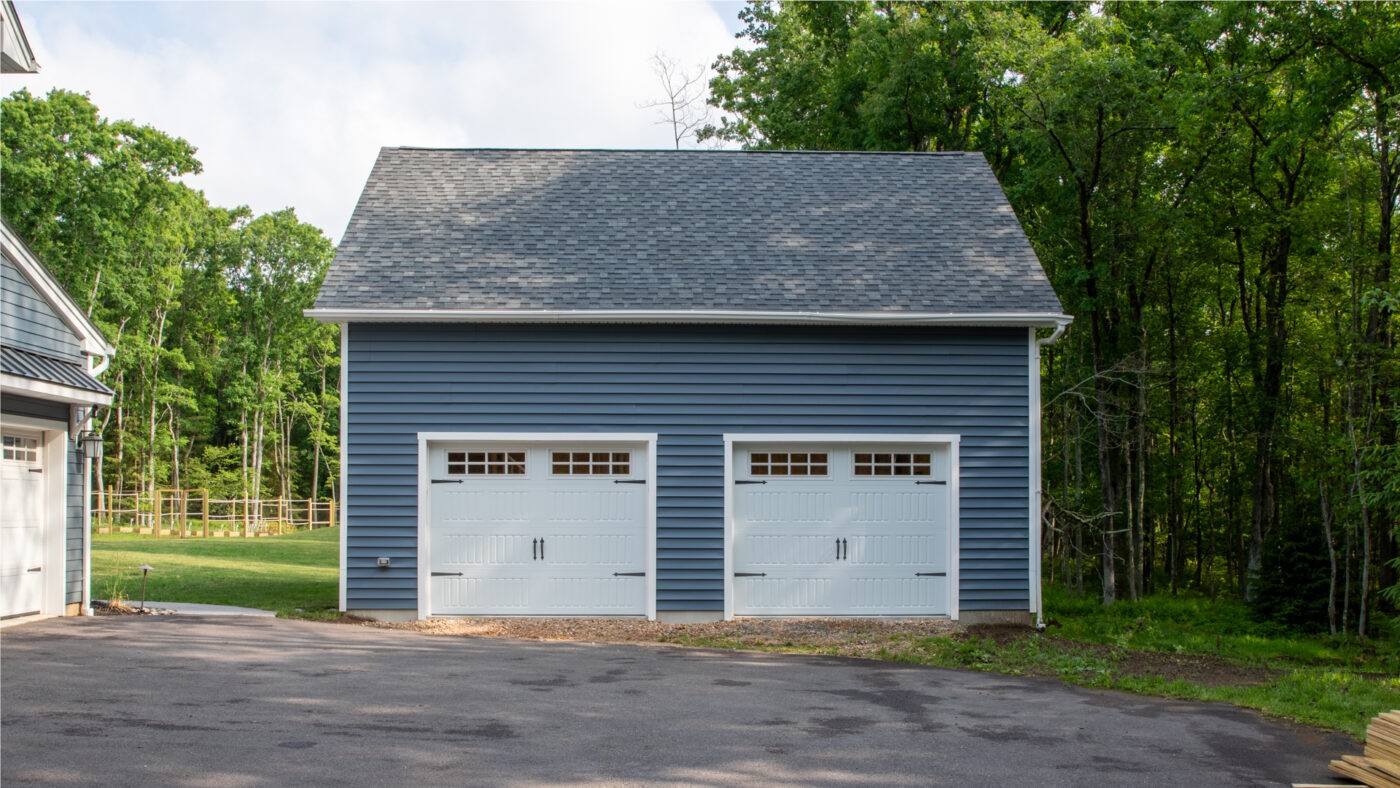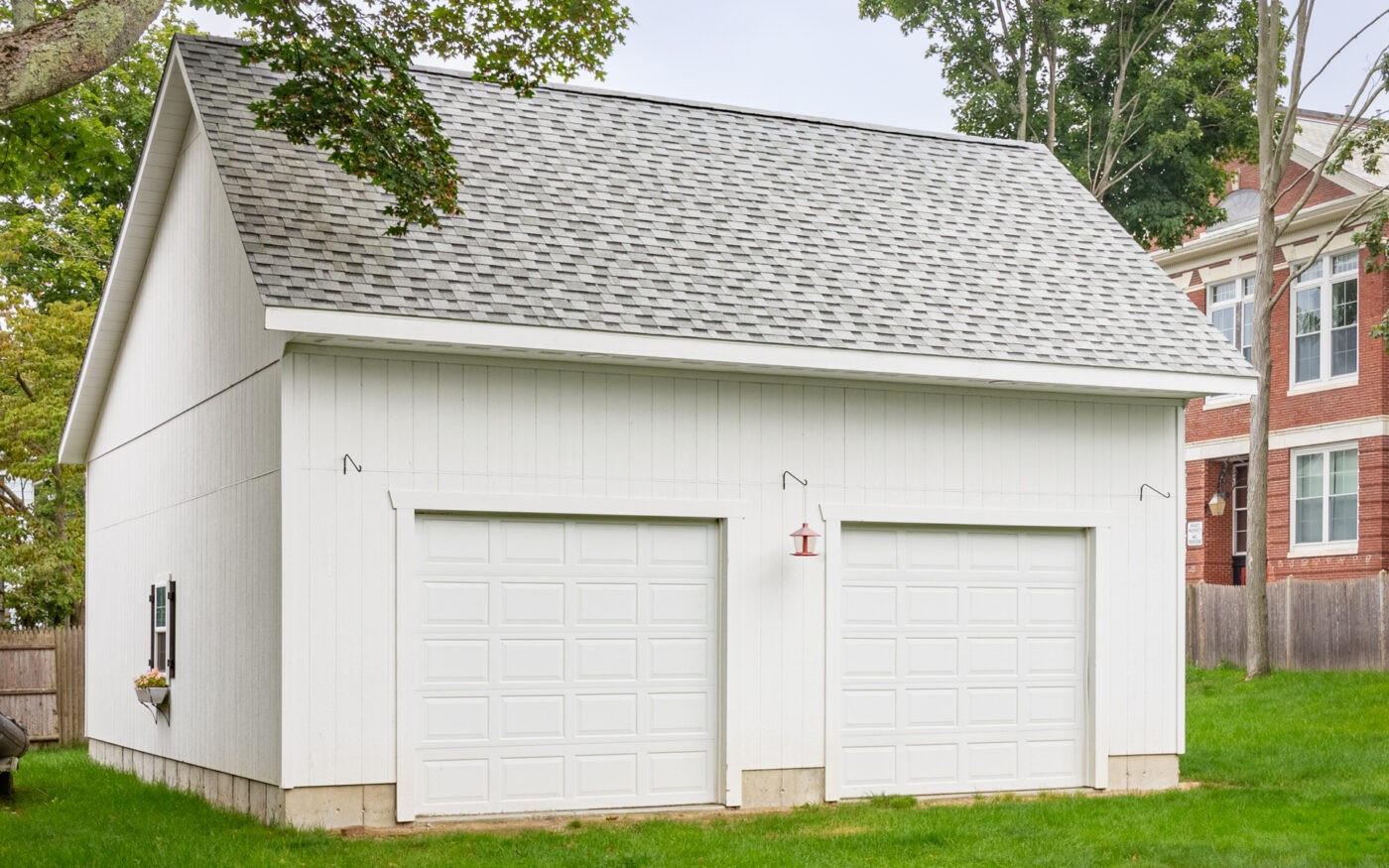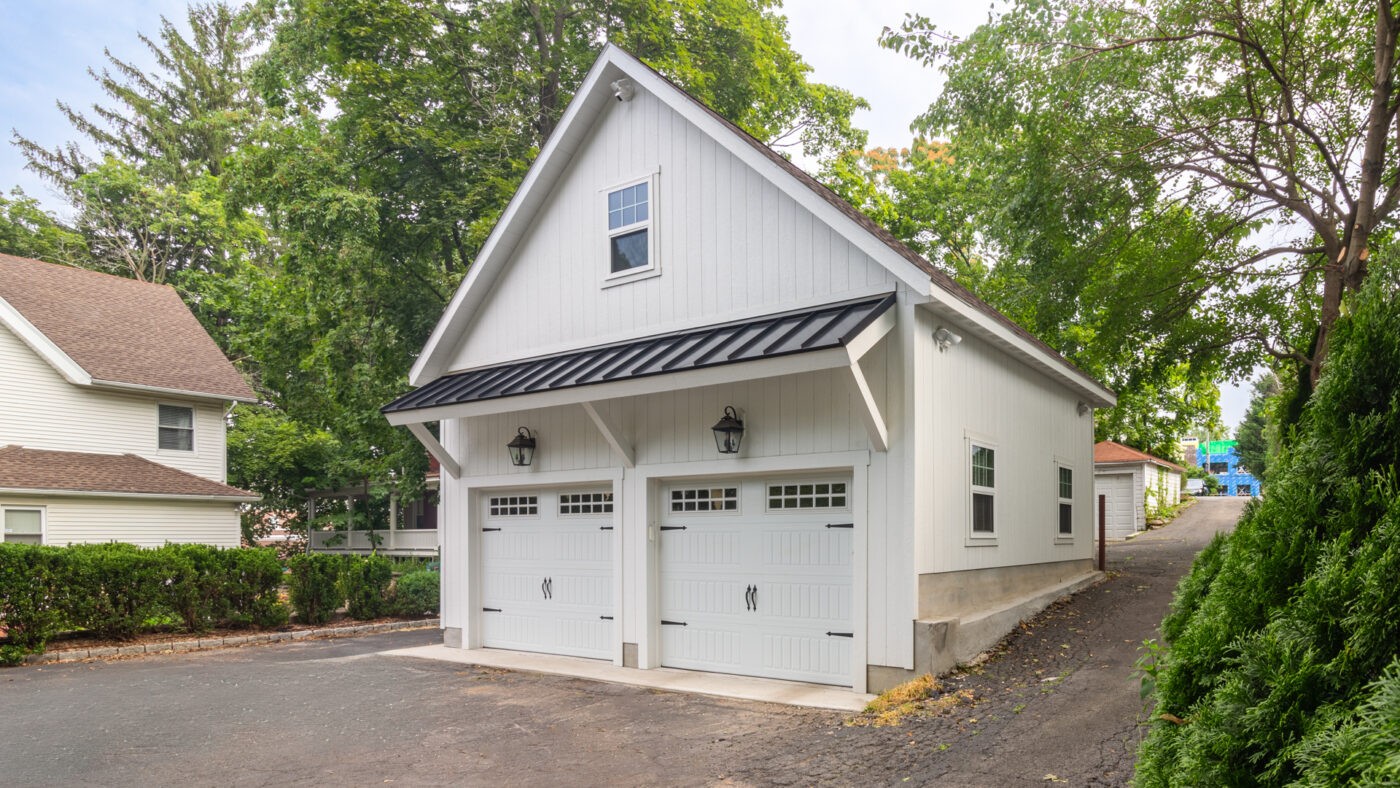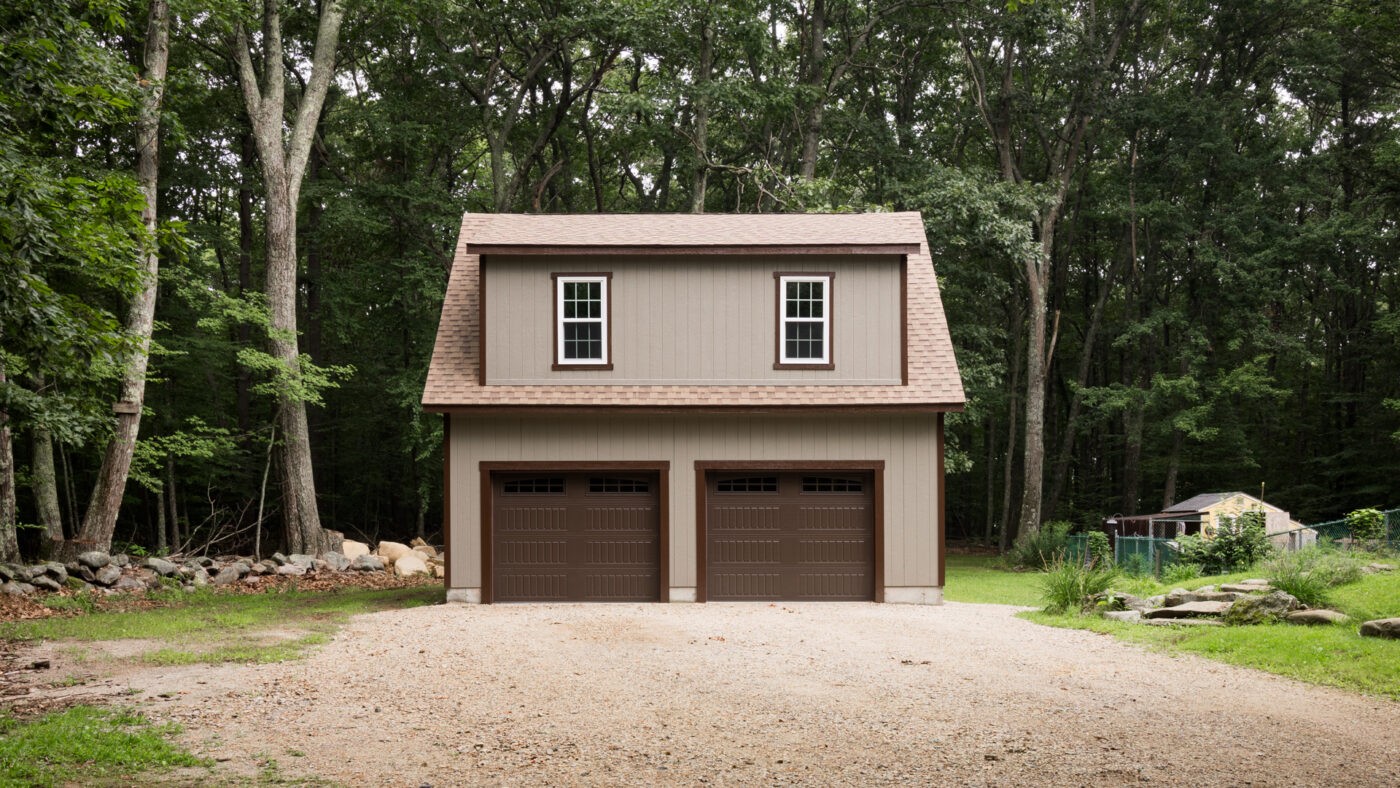What Are The Dimensions Of A Two Car Garage? Finding the ideal garage size can feel overwhelming, but with the right information, you can make the perfect choice. CARS.EDU.VN simplifies this process, offering expert guidance on selecting the optimal two-car garage size that meets your specific needs and preferences. Discover the dimensions of a 2-car garage, typical garage measurements, and two-car garage space.
1. Understanding Two-Car Garage Sizes
The size of a two-car garage depends on your specific needs and the intended use of the space. Do you plan to park two compact cars or larger vehicles? Will you need extra room for storage or projects? Standard two-car garage sizes typically range from 20×20 feet to 28×28 feet. Let’s delve into the common dimensions:
| Standard 2-Car Garage Size | Dimensions (feet) | Square Footage |
|---|---|---|
| Minimum | 20×20 | 400 |
| Average | 22×22 | 484 |
| Average | 24×24 | 576 |
| Average | 24×30 | 720 |
| Large | 28×28 | 784 |






These dimensions provide a starting point for planning your garage. The size you ultimately choose should reflect how you intend to use the space. For a deeper understanding, CARS.EDU.VN offers resources and expert advice to help you customize your garage to your lifestyle.
2. Minimum Two-Car Garage Dimensions: Balancing Cost and Space
If you’re aiming to minimize costs, the minimum recommended size for a two-car garage is 20×20 feet (400 square feet). A slightly larger size of 22×22 feet (484 square feet) can provide a bit more comfort. However, opting for the smallest size can present several challenges:
- Limited Storage: Minimal space for tools, workbenches, and other storage needs.
- Smaller Doors: Reduced garage width may require using smaller 8-foot wide doors instead of the standard 9 or 10-foot doors.
- Risk of Door Dents: Tight spaces increase the chance of car doors hitting the walls or other vehicles.
- Reduced Resale Value: Potential buyers may find a smaller garage less appealing due to limited space.
According to a study by the National Association of Home Builders, garage size is a significant factor for homebuyers. A smaller garage might deter potential buyers or lower your home’s value.
At CARS.EDU.VN, we understand the importance of balancing cost and functionality. Explore our resources to find the best compromise for your budget and needs.
3. Average Two-Car Garage Dimensions: Finding the Sweet Spot
The average size for a two-car garage typically falls between 24×24 feet (576 sq ft) and 24×30 feet (720 sq ft). These dimensions provide a comfortable balance between parking space and additional room for storage or other uses. Here’s a breakdown of what these average dimensions offer:
| Feature | Dimensions (feet) | Details |
|---|---|---|
| Width | 24 | Allows ample space for opening car doors and maneuvering around vehicles. |
| Length/Depth | 24-30 | Accommodates most vehicles with extra space for storage or a workbench. |
| Height | 8-20 | Standard ceiling height allows for overhead storage and some vehicle lifts. Higher ceilings can accommodate more storage or specialized equipment. |
3.1. Width Considerations
A minimum width of 24 feet is highly recommended. The average car width is approximately 6 to 6.5 feet. Parking two cars side-by-side requires about 13 feet. Adding 2 to 3 feet of space on each side ensures comfortable maneuvering and reduces the risk of dents.
3.2. Length/Depth Insights
The length of your garage should accommodate the size of your vehicles and any additional storage or workspace you plan to include. A typical sedan is around 17 feet long. A depth of 24 to 30 feet provides enough room to walk around the back of your car and store items like lawn equipment or tools.
3.3. Height Advantages
Adequate height is essential for storage. The average ceiling height for a two-car garage is about 8 feet, while the garage door is typically 7 feet high. If you own a truck, van, or plan to install a vehicle lift, consider increasing the height of your garage.
CARS.EDU.VN offers insights into optimizing garage space, helping you make the most of your available area.
4. Maximizing Space: Functionality and Dimensions
Determining the function of your garage is crucial before deciding on dimensions. Consider these questions:
- Vehicle Size: Do you own compact cars or large SUVs?
- Storage Needs: Will you need shelves or storage in front of or beside your vehicles?
- Workbench: Do you need space for a workbench or other project area?
- Extra Space: Do you want to use the garage for hosting events or as a workspace?
4.1. Questions to Guide Your Decision
- Am I planning to store more than two vehicles in this garage?
- Is extra storage space important to me?
- Do I want to use my garage as an extra space to host guests for meals and events?
- Is there anyone in my household who needs a small apartment or workspace above the garage?
- Do I have room on my property for one of the larger two-car garages?
- Does my budget allow for larger two-car garage square footage?
- Do I need space for a trash and recycling area within the garage?
- Do I anticipate my storage needs increasing in the future?
- Will I need space for a lawnmower, snow blower, or other large outdoor equipment?
- Will I need a separate entrance or exit for convenience or safety reasons?
4.2. Maximizing Garage Space
Think about adding storage solutions like overhead racks, wall-mounted shelves, or a tool chest. Properly organizing your garage can significantly increase its usability and prevent it from becoming cluttered.
According to a survey by Garage Living, homeowners who invest in garage organization solutions report a 25% increase in usable space.
CARS.EDU.VN can provide information on garage design and organization, ensuring your garage meets your unique needs.
5. Building Codes and Regulations: What You Need to Know
Before finalizing your garage plans, it’s essential to understand local building codes. Most areas allow garages under 1,000 square feet, but specific regulations may vary. Check with your local government regarding size restrictions, setback requirements, and zoning laws.
5.1. Permits and Regulations
- Building Permits: Required for attached garages and often for detached garages.
- Zoning Permits: May be necessary for detached garages depending on local regulations.
- Setback Requirements: Dictate how far the garage must be from property lines.
- Size Restrictions: Maximum allowable size for garages.
Failing to comply with local building codes can result in fines, construction delays, or even legal action. Consulting with a local contractor or building inspector can help ensure your project meets all requirements.
CARS.EDU.VN can offer advice on navigating building codes, helping you avoid costly mistakes.
6. Two-Car Garage Dimensions: Width, Length, and Height Breakdown
When planning a two-car garage, understanding the nuances of width, length, and height is essential. These dimensions not only affect how you park your cars but also the overall functionality of the space. Let’s break down each element:
6.1. Optimal Width for a Two-Car Garage
A garage width of at least 24 feet is highly recommended for comfortable parking. Here’s why:
- Car Width: The average car measures between 6 and 6.5 feet wide. Two cars side by side require approximately 13 feet.
- Maneuvering Space: Having at least 2 to 3 feet on each side of the vehicles allows for easy entry and exit without risking dents or scratches.
- Storage: Extra width accommodates storage along the walls, such as shelves or cabinets, without compromising parking space.
While a minimum width of 20 feet is possible, it significantly reduces maneuvering space and storage capacity. Aiming for 24 feet ensures a more functional and user-friendly garage.
6.2. Determining the Ideal Length/Depth
The length of your garage depends on the size of your vehicles and the intended use of the space beyond parking. Key considerations include:
- Vehicle Length: A typical sedan is about 17 feet long. SUVs and trucks may require more space.
- Walking Space: Allow enough room to walk comfortably around the back of the vehicle, even with the garage door closed.
- Storage: Additional length provides space for storage shelves, workbenches, or other equipment.
A depth of 24 to 30 feet is generally recommended for a two-car garage. This allows ample space for most vehicles, along with extra room for storage or a small workspace. If you plan to work on your vehicles inside the garage, consider opting for a 30-foot depth.
6.3. Height Considerations for Storage and More
The height of your garage significantly impacts storage options and overall functionality. Factors to consider include:
- Standard Height: The average ceiling height in a two-car garage is around 8 feet, with a typical garage door height of 7 feet.
- Vehicle Type: If you own a truck, van, or plan to store an enclosed trailer, you may need a higher garage door and ceiling.
- Overhead Storage: Extra height allows for installing overhead storage racks, maximizing vertical space.
- Garage Door Opener: Ensure at least two inches of headroom above the garage door for proper opener installation.
If you plan to use a vehicle lift, need ample overhead storage, or want to accommodate larger vehicles, opting for a garage with a higher ceiling is a wise investment.
CARS.EDU.VN can offer insights into optimizing garage dimensions based on your specific vehicles and storage needs.
7. Functionality: What Will Your Garage Be Used For?
Before settling on dimensions, clearly define how you intend to use your two-car garage. This will guide your decision-making process and ensure you create a space that meets your needs. Here are some questions to consider:
7.1. Essential Questions to Ask Yourself
- What size are your vehicles? (Compact car, sedan, SUV, truck)
- Are you planning to store more than two vehicles? (Motorcycles, ATVs, etc.)
- Do you need storage shelves in front of or beside your vehicles?
- Do you need a workbench or tool storage area?
- Is extra storage space important to you?
- Do you want to use your garage as an extra space to host guests or for events?
- Do you need space for lawn equipment, snow blowers, or other outdoor gear?
- Do you anticipate your storage needs increasing in the future?
- Do you need a separate entrance or exit for convenience or safety reasons?
7.2. Planning for Versatility
If you foresee multiple uses for your garage, plan for versatility. Consider incorporating flexible storage solutions, like modular shelving or wall-mounted cabinets, that can be easily reconfigured. Including a work area with good lighting and power outlets can also add to the garage’s functionality.
7.3. Customizing for Your Lifestyle
Your lifestyle plays a significant role in how you use your garage. A car enthusiast may prioritize a well-equipped workspace, while a family with young children may focus on storage for bikes, sports equipment, and outdoor toys.
By considering your lifestyle and how you intend to use your garage, you can create a space that truly enhances your daily life.
CARS.EDU.VN can offer ideas and inspiration for customizing your garage to fit your unique lifestyle.
8. Decoding Building Codes: Ensuring Compliance
Before starting any construction, it’s crucial to understand your local building codes and regulations. These codes dictate various aspects of your garage, including size, setback requirements, and construction standards.
8.1. Key Regulations to Consider
- Permitting: In most areas, you’ll need a building permit for both attached and detached garages. Check with your local building department for specific requirements.
- Zoning: Zoning regulations dictate how the land can be used. They may specify minimum lot sizes, setback requirements, and maximum building heights.
- Setbacks: Setback requirements determine how far your garage must be from property lines, streets, and other structures.
- Size Restrictions: Local codes may limit the maximum size of your garage based on lot size and zoning regulations.
8.2. Navigating the Permitting Process
The permitting process can seem daunting, but with proper preparation, it can be relatively straightforward. Gather all necessary documents, including site plans, construction drawings, and any required surveys. Be prepared to answer questions about your project and address any concerns raised by the building department.
8.3. Avoiding Costly Mistakes
Failing to comply with building codes can result in fines, construction delays, or even legal action. Consulting with a local contractor or building inspector can help you navigate the complexities of building codes and ensure your project meets all requirements.
CARS.EDU.VN can offer resources and links to local building departments, helping you navigate the regulatory landscape.
9. Budgeting for Your Two-Car Garage: Cost Considerations
The cost of building a two-car garage can vary widely depending on several factors, including size, materials, design, and location. Understanding these cost drivers can help you create a realistic budget and avoid surprises.
9.1. Factors Influencing Garage Costs
- Size: Larger garages require more materials and labor, increasing the overall cost.
- Materials: The choice of materials, such as wood, vinyl, or metal, significantly impacts the price.
- Design: Custom designs or intricate architectural features can add to the cost.
- Location: Labor and material costs vary by region.
- Features: Adding features like insulation, electrical wiring, and custom doors increases expenses.
9.2. Estimating Your Garage Costs
Research local material and labor costs to estimate your project’s expense accurately. Obtain multiple quotes from contractors to ensure you’re getting a competitive price. Consider using online cost calculators to get a rough estimate of the project’s overall expense.
9.3. Value Added By A Garage
A well-designed and properly constructed garage is an investment that can pay dividends in the long run. Besides protecting your vehicles and providing storage space, a garage can increase your home’s value and improve its curb appeal.
According to a study by Remodeling Magazine, adding a garage to your home can increase its resale value by as much as 5%.
CARS.EDU.VN can provide insights into the return on investment of garage construction, helping you make informed decisions.
10. Exploring Garage Styles: Attached vs. Detached
Choosing between an attached and detached garage involves weighing various factors, including space, budget, and lifestyle. Both options offer unique advantages and disadvantages.
10.1. Attached Garages: Convenience and Connectivity
Attached garages are connected to the house, offering convenience and easy access to your vehicles. They are ideal for colder climates, providing protection from the elements.
Advantages:
- Convenient access to the home
- Protection from weather
- Cost-effective (shared wall with the house)
- Easier to add electricity and plumbing
Disadvantages:
- Limited design flexibility
- Noise transfer into the home
- Potential for fumes and odors to enter the house
- May require modifications to the existing structure
10.2. Detached Garages: Versatility and Privacy
Detached garages stand apart from the house, offering more design flexibility and privacy. They are often preferred for workshops or hobby spaces.
Advantages:
- Greater design flexibility
- Noise isolation from the house
- Can be built further from the property line
- Potential for a separate workshop or living space
Disadvantages:
- Less convenient access to the home
- Exposure to the elements
- Generally more expensive to build
- Requires separate utility connections
10.3. Choosing the Right Style
The best choice depends on your specific needs and preferences. If convenience and cost are primary concerns, an attached garage may be the better option. If you value design flexibility and privacy, a detached garage may be more suitable.
CARS.EDU.VN offers comprehensive guides to both attached and detached garages, helping you weigh the pros and cons.
11. Garage Door Dimensions: Standard Sizes and Considerations
Garage doors play a crucial role in the functionality and security of your garage. Selecting the right size is essential for accommodating your vehicles and ensuring smooth operation.
11.1. Standard Garage Door Sizes
- Single Car Garage Door: Typically 8 to 10 feet wide and 7 feet high.
- Two-Car Garage Door: Usually 16 feet wide and 7 or 8 feet high.
These are standard dimensions, but custom sizes are available to accommodate larger vehicles or unique architectural designs.
11.2. Factors to Consider When Choosing a Garage Door Size
- Vehicle Size: Measure the width and height of your vehicles, including side mirrors and roof racks.
- Headroom: Ensure enough headroom above the garage door for the door to open fully without hitting the ceiling.
- Sideroom: Check for adequate sideroom on each side of the door for proper installation and operation of the tracks and hardware.
- Building Codes: Verify local building codes for any specific requirements regarding garage door sizes or safety features.
11.3. Materials and Styles
Garage doors come in a variety of materials and styles, including steel, wood, aluminum, and fiberglass. Choose a material that complements your home’s architecture and provides the desired level of durability and insulation.
CARS.EDU.VN offers reviews and comparisons of different garage door materials and styles, helping you make an informed decision.
12. Garage Storage Solutions: Maximizing Space and Organization
Efficient storage is essential for keeping your garage organized and functional. Numerous storage solutions can help you maximize space and keep your belongings accessible.
12.1. Wall-Mounted Storage
Wall-mounted shelves, cabinets, and tool racks are great for keeping items off the floor and within easy reach. They are ideal for storing tools, sports equipment, and seasonal items.
12.2. Overhead Storage
Overhead racks utilize the vertical space in your garage, providing ample storage for bulky items like holiday decorations, luggage, and camping gear.
12.3. Mobile Storage
Rolling tool chests, carts, and workbenches offer flexibility and convenience. They can be easily moved around the garage to suit your needs.
12.4. Custom Storage Systems
Custom storage systems are tailored to your specific needs and space. They can incorporate a variety of storage solutions, including shelves, cabinets, drawers, and work surfaces.
CARS.EDU.VN offers tips and ideas for creating a custom garage storage system that meets your needs and budget.
13. Expert Advice: Tips for Planning Your Two-Car Garage
Planning a two-car garage involves numerous decisions, from size and style to storage and budget. Here are some expert tips to guide you through the process:
13.1. Define Your Needs
Clearly define how you intend to use your garage. Consider your vehicle size, storage needs, and any other activities you plan to pursue in the space.
13.2. Research Local Codes
Understand your local building codes and regulations. Contact your local building department for information on permitting requirements, setback regulations, and size restrictions.
13.3. Create a Budget
Establish a realistic budget based on your research and desired features. Obtain multiple quotes from contractors to ensure you’re getting a competitive price.
13.4. Plan for the Future
Consider your future needs. Will your storage requirements increase over time? Do you anticipate acquiring larger vehicles? Planning for the future can help you avoid costly renovations down the road.
13.5. Consult with Professionals
Don’t hesitate to consult with architects, contractors, and building inspectors. Their expertise can help you navigate the complexities of garage construction and ensure your project meets all requirements.
CARS.EDU.VN offers a directory of qualified professionals in your area, making it easy to find the help you need.
14. Maximizing Resale Value: Building a Garage That Appeals to Buyers
If you plan to sell your home in the future, building a garage that appeals to potential buyers can increase its resale value. Here are some factors to consider:
14.1. Size and Functionality
A two-car garage is generally more desirable than a one-car garage or no garage at all. Opt for a size that can comfortably accommodate two vehicles and provide ample storage space.
14.2. Design and Aesthetics
Choose a design that complements your home’s architecture and enhances its curb appeal. Use high-quality materials and finishes to create a polished look.
14.3. Storage Solutions
Incorporate efficient storage solutions to showcase the garage’s organization potential. Wall-mounted shelves, overhead racks, and custom storage systems can impress potential buyers.
14.4. Features and Amenities
Adding features like insulation, electrical wiring, and custom garage doors can make your garage more appealing to buyers.
14.5. Maintenance and Condition
Keep your garage well-maintained and in good condition. Regular cleaning, painting, and repairs can create a positive impression on potential buyers.
CARS.EDU.VN can provide insights into the features and amenities that add value to a home’s garage, helping you maximize your return on investment.
15. Two-Car Garage FAQs: Answers to Your Questions
15.1. What is the standard size of a two-car garage?
The standard size is typically between 20×20 feet and 24×24 feet, offering space for two vehicles and some storage.
15.2. What is the minimum size for a two-car garage?
The minimum size is usually 20×20 feet, but this offers very little extra space.
15.3. How much does it cost to build a two-car garage?
Costs vary depending on size, materials, and location. A basic garage can start around $15,000, while a more elaborate one can exceed $50,000.
15.4. What size garage door do I need for a two-car garage?
A 16-foot wide door is standard, but two single doors (8 or 9 feet wide each) are also an option.
15.5. How can I maximize storage in my two-car garage?
Use wall-mounted shelves, overhead racks, and custom storage systems to keep items off the floor and organized.
15.6. Do I need a permit to build a two-car garage?
Yes, in most areas, a building permit is required. Check with your local building department for specific requirements.
15.7. What are the benefits of an attached garage?
Attached garages offer convenient access to the home and protection from the weather.
15.8. What are the benefits of a detached garage?
Detached garages offer more design flexibility and privacy.
15.9. How do I choose the right garage door material?
Consider factors like durability, insulation, aesthetics, and budget. Steel, wood, aluminum, and fiberglass are common options.
15.10. How can a garage increase my home’s resale value?
A well-designed and properly constructed garage can enhance curb appeal, provide storage space, and increase your home’s overall value.
Ready to Build Your Perfect Garage?
Choosing the right dimensions for your two-car garage is crucial for maximizing functionality and value. Whether you need a compact space for basic parking or a larger area for storage and hobbies, CARS.EDU.VN is here to help.
Don’t let the complexities of garage planning overwhelm you. Visit CARS.EDU.VN today to explore detailed guides, expert advice, and helpful resources.
- Find local contractors and building professionals.
- Browse garage designs and storage solutions.
- Learn about building codes and permitting requirements.
- Get personalized recommendations for your specific needs.
Take the first step toward creating the garage of your dreams with CARS.EDU.VN.
Contact us today:
Address: 456 Auto Drive, Anytown, CA 90210, United States
WhatsApp: +1 555-123-4567
Website: CARS.EDU.VN
Let cars.edu.vn guide you in making the right choices for your home and vehicles. We can assist you in finding reliable repair services, understanding maintenance schedules, and even comparing different car models to ensure your automotive needs are met with expertise and care.
